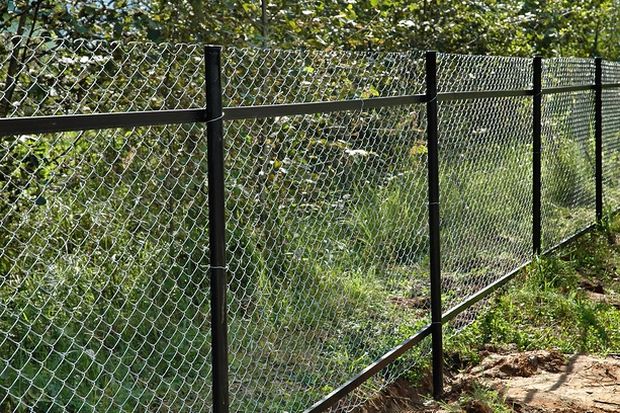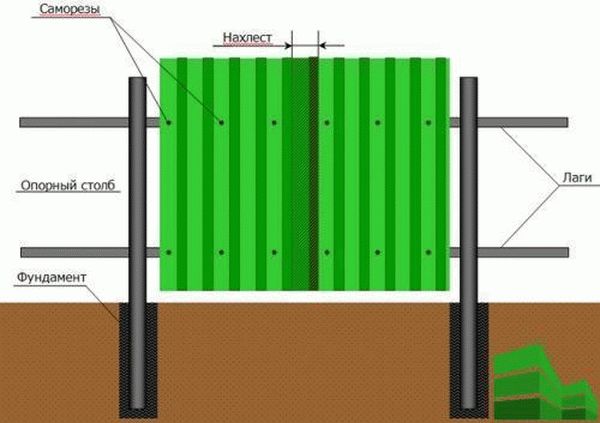Purpose fence
is to protect territory and property from entry by strangers, as well as marking the boundaries of your possessions.
But its construction requires multiple approvals, knowledge of laws and regulations.
Therefore, you need to understand that installing a fence between neighbors provides not only a beautiful fence installed at your whim, but also, above all, the correct designation of the territory legally.
Neighbors, as they say, are not chosen, so among them there are not always loyal people. And when you have private property, conflicts and quarrels may arise based precisely on the division of existing boundaries. If this happens, you should distinguish your zone from someone else's. It’s good if you know the rules for building fences. The presence of documents confirming the boundaries of the territory must be mandatory. The boundaries of the site must be agreed upon and a document must be drawn up, which must then be signed. After these steps, you need to inquire with the local architectural department about the boundaries of your site and the permissible height of the fence
, and what type of material is suitable for constructing a fence on your property.
It is also important to know all this so as not to disrupt the power supply, water supply and sewerage systems. So the rules and regulations for installing a fence.
Fence height between neighbors
We should not forget about the height of the fence
- no more than one meter. Such a height will not create a shadow on the neighbors’ territory. Based on the height of the fence, you can even form an opinion about your relationship with your neighbors. Thus, a high fence “speaks” for itself that the relationship is not very friendly; the lower the height, the more loyal they are (from popular sayings). According to the standards for arranging fences for gardens, country houses and other non-profit associations (Federal Law No. 66-F3), all structures, including the fence, must be erected in accordance with the established design. Control over the buildings is exercised both by the board of the association and the author of the project himself. Members of this association are allowed to choose designs and types of materials for the necessary buildings and fences, among other things. In this regard, we can say that the construction of a fence should begin with settling all current issues in the relevant organizations and preparing the necessary documents. And then you will not have difficulties affecting the construction process, and knowledge of the norms for building fences will help you in this matter.
Rules for constructing a fence between plots
When organizing the construction of any fencing, it is necessary to agree on many issues and draw up a number of mandatory documents. The existing legislative framework “plays” in regulating the process of approving plot boundaries, designing fences, as well as complying with all construction standards.
Coordination of site boundaries.
Even at the preliminary stage
of fence construction,
you need to prepare documents indicating the correct boundaries of the site. The boundary and cadastral plans must describe these boundaries and the fenced area from the adjacent territory. Owners of plots that border your homestead territory must have similar documents. During the border approval procedure, all neighbors taking part in this must have these documents with them. The official part includes the signing of an act agreeing on the location of the boundaries of the site. But it happens when the neighbors have no complaints. The cadastral engineer must record and document the results. The document is considered officially agreed upon after signatures between interested parties. After the approval act is approved, it is attached to the land survey plan.
Surveyor services to resolve disputes.
No one is immune from disagreements and disputes over the boundaries and areas of property. They periodically arise between the owners of neighboring plots. To avoid such a fate, it is better to resort to the services of specialists in the use of land resources - surveyors. To carry out the work, such specialists will need to submit a detailed Technical Specification document and a site plan. Upon completion of the work, the specialist will give the customer (client) a prepared plan for the territory indicating the located boundary signs. The act of transfer of boundary marks must be approved by the relevant authorities, in those where this land plot is accountable. The owner of the site is responsible for the timely completion of the procedure.
This is interesting: Does the HOA pay land tax?
Possible restrictions and prohibitions on construction work.
But this is not the entire preparatory stage.
It is necessary to consult the department of urban planning and architecture. They are the ones who control the land plots, including the location of your site. It is the responsibility of the specialists of these institutions to inform clients about possible prohibitions or restrictions on the construction of structures in the areas under their control, since these lands may contain utilities (water supply systems, power transmission). It should be borne in mind that the erected fence
may be considered illegal if you ignore the above procedures, as well as in the absence of the consent of neighbors, and the absence of official confirmation by authorized persons or organizations. In this case, the fence will have to be dismantled. Of course, the unlucky owner of the site will not receive any material compensation.
Rules governing the construction of a fence
When building fences for their personal or garden plots, owners should carefully familiarize themselves with the existing development standards for the given area. The main provisions include the following points: When constructing any structures or buildings in country houses, gardens, non-profit associations, it is necessary to comply with all the rules and instructions of the current project of organizations and developments in the given territory. The board of a dacha, gardening association, and inspectors representing government agencies can be the persons controlling the process of erecting fences and ensuring compliance with legislative norms. Organization and development projects must specify the maximum permissible boundaries of structures, including fences. But according to the official approval of projects by local authorities, during the construction of structures, the permissible dimensions may be overestimated. Everything must be approved in accordance with established urban planning legislation. There are also a number of restrictions in the current requirements for fencing personal plots. To avoid shading the neighbors' areas, fences should not exceed 1.5 meters in height, and it is better to give preference to lattice and mesh types.
Blind fences can be made on sides that do not border neighboring areas. All fences made between areas must have the ability to transmit sunlight. Requirements for materials for the manufacture of fences and their heights are determined by the Charter of controlling organizations (gardening or dacha partnerships). All these provisions must be observed at the initial stage, that is, before purchasing construction materials and before design work.
Why build a fence on a garden plot? This method is the most practical for marking a personal territory. The fence protects the home from intruders and closes it from prying eyes. The fence clearly separates the plots along the boundary, which prevents possible damage, especially at the early stage of the formation of a holiday village.
We study the norms and requirements for constructing a fence in a garden plot
When erecting fences on a garden plot, it is recommended to focus on those recorded in regulatory documents. Any non-compliance of a building with legal standards often leads to fines or other penalties, and in cases of serious violations, to deprivation of property rights. That is why, before erecting a fence, it is important to familiarize yourself with existing laws and strictly comply with the norms specified there
.
Basic standards for installing a fence
Federal law in Article No. 66 notifies that each construction is carried out in accordance with an authorized project, where fencing between private areas is no exception. Garden plots must comply with established standards.
However, there is no separate legislative decision related to the installation of a fence in the Russian Federation. But the requirements, rules and recommendations are provided for by construction regulations (SNiP) No. 30-02-97, approved by the State Construction Committee. This document defines the general rules and regulations for the construction of fencing, the degree of transparency, the height of the structure, the choice of material, and so on.
How to agree on the boundaries of a site before erecting a fence - review of documents for drawing up boundaries
Agree on the boundaries of the site
- this means completing the mandatory stage preceding the start of construction of the fence. To carry it out, you need documents that describe data on the border of the site, its area, as well as adjacent territories. The listed data is reflected in survey and cadastral documents. Neighbors whose territories adjoin your site take part in the approval process and submit similar documents.
If, after analyzing the documentation, the neighbors have no objections, then the cadastral engineer draws up an approval act. The procedure is completed after the document is signed by all interested parties. Next, the cadastral engineer must certify the act. The approved document is stored together with the boundary plan.
If disputes arise regarding the location of the future fence,
it is necessary to call surveyors to measure the boundaries of the site. You must accurately explain to them the essence of the claim to your fence, provide documents reflecting its location plan, construction permit, and technical specifications. After the work has been completed, geodesy specialists hand over to the owner of the site a document indicating the boundary signs and an act indicating that the boundary signs have been transferred under the responsibility of the owner of the site.
We are building a fence on a garden plot - standards for building a fence
Special laws and SNiPs contain regulations for the garden plot. And if laws are mandatory, then SNiP is a recommendation.
In accordance with building codes and regulations
the fence on the garden plot should be located at a certain distance relative to the following objects:
There are legislative standards regulating the construction on the territory of non-profit associations of horticultural (dacha) type. Before starting construction of a fence, the owner of a garden plot must take into account the approved development standards. According to their requirements, the main points are as follows
:
- the construction of buildings in a gardening association is permitted only according to a specific territory development project;
- compliance with requirements during the construction of objects is monitored by the board of the association together with inspectors of government agencies;
- materials used in the construction of structures and infrastructure are determined by the members of the horticultural association independently, in accordance with the organization and development project;
- if buildings and structures erected on plots exceed the parameters determined by the project of a horticultural non-profit association for these structures, it is necessary to approve the changes (this issue is dealt with by self-government bodies).
Fence installation regulatory documents
Before obtaining official permission to build a fence, you need to discuss and agree with the neighbors about the dimensions and installation location of the future fence, and a land survey must be carried out. The construction of a fence involves joint efforts by both parties, including the cost of a much-needed undertaking. This agreement must be recorded in writing. In the future, this document will serve as evidence of the decision made and will help avoid creating a conflict situation and misunderstanding.

So, the legislation determines the fulfillment of the following requirements:
- The construction of any structure, including fencing systems, must comply with the regulations of the non-profit organization within which the land area is located.
- The design of a construction structure, in particular a fence, is approved by regulatory authorities - a local organization or an employee of a special government agency.
- The certified project provides for the maximum parameters of the future design. Any changes are carried out only with the permission of the relevant authorities.
- The stages of fence construction must comply with urban planning standards (with the exception of force majeure).
If you can’t come to a common denominator when talking with a neighbor, then you need to contact the legal authorities. In such a situation, it becomes possible to receive a penalty for refusing to comply with regulatory requirements, in particular the construction of a fence between sites.
Standards for installing a fence between neighbors in a private house
The precise determination of the boundaries of the land plot is carried out by surveyors. When contacting a competent person, you must provide all documents to the territory. After inspecting the area and checking the documentation, a plan diagram of the agricultural property will be generated indicating boundary signs. It must also be indicated who is installing the fence, whose fence will be, where it will be located: in the private sector, in a village or in a private house, whether this action was agreed upon.
The next step will be obtaining permission to carry out construction work. For permission, a citizen should contact the urban planning department. It is advisable to pre-coordinate this action with your neighbors.
The municipality itself determines the greatest height of the future fence between the two territories.
The requirements for the raw materials used to erect a fence at the dacha are specified in the Charter of SNT (garden non-profit partnership). The main indicator is light transmission, in order to prevent a large shadow from falling on another plot.
When constructing enclosing structures, it is extremely important to comply with sanitary requirements:
- retreat 0.5 meters from the border of the neighboring plot;
- there should be at least 3 meters to residential premises;
- buildings for livestock - from 4 meters;
- to other types of structures - from 1 meter;
- trees - from 2 to 4 meters, depending on their height: the higher the tree, the further the fence is installed.
The law provides for mandatory compliance with fire safety regulations. The distance allowed for indentation from buildings directly depends on the type of materials from which they are built:
| Concrete | At least 6 meters |
| Stone or concrete buildings with wooden floors | More than 8 meters |
| Tree | From 15 meters |
| Between stone and/or concrete buildings, regardless of the type of floor | Not less than 8 meters |
| Wooden and concrete (or stone) with or without wooden flooring | More than 20 meters |
The law does not provide for a minimum distance between buildings.
Sanitary standards when installing a fence

There are indicators of the distance at which the fence is located. They see the following points:
- The gap between the living space and the fence is at least three meters.
- The distance between the fence and the utility building is at least one meter.
- Roof slopes and balconies are positioned so that water flows onto your property.
- The distance between the fence and large trees is four meters, medium-height trees are two meters, and bushes are one meter.
What material is best to build a fence from?
The amount of material consumed is determined by the design drawing drawn up by the architect. The diagram is marked with the position of the future fence, the installation location of the support pillars and the area of the structure.
Among the numerous assortment of materials, you need to choose the optimal option for the land owner.
Installation of a wooden fence is recommended for citizens who care about the environmental friendliness of the structure. This type of raw material is very reliable and can be dyed or not. The surface may have natural wood patterns or carved designs. It is necessary to treat the fence with a special coating every year to prolong the performance of the fence and maintain its appearance.
A chain-link fence has increased light transmittance, which significantly reduces the risk of damage to vegetables and fruits growing on the site. This type of raw material is characterized by low cost and ease of installation. The mesh is installed in spans without overlapping, which means that when damage occurs, there will be no need to completely replace the fence. It will be enough to replace the damaged part.
This is interesting: The position of the Supreme Court on the redistribution of land plots
Forged iron products will not only last a long time, but also comply with legal requirements, transmit light and create aesthetic beauty.
If a combined type of flooring is used, it is recommended to install the lower blind part first.
The choice of material will depend entirely on the preferences of the owner and, at his request, it will be possible to later replace one with the other. For example, instead of a wooden fence, install an iron one, which will not need to be documented.
Preparatory work for the fence between neighbors
The first stage of the preparatory work will be to determine the type of foundation. Possible use:
- low-depth strip foundation;
- stepped base;
- point fastening.
Pouring a reinforced concrete base begins with digging a trench. The tape design requires a continuous trench. A sand cushion is poured onto the bottom, watered and tamped. Reinforcement rods are laid on top, first along, then across, and the formwork is placed. Now pour the concrete solution and wait for complete hardening. The final stage is removing the formwork and pouring soil or gravel on the sides.

A stepped foundation is used when the height of the landscape is uneven, or when there are sudden changes in soil level. Each step must be placed flush with the soil surface. In order to ensure a smooth transition, several ledges are made, the optimal height of each should not be less than 60 centimeters. On average, the length of the ledges is two to three times greater than the height.
With point fastening, a separate recess will be dug under each post, after which the post will be inserted, leveled or plumb, and filled with building mixture.
The base for erecting the fence should provide maximum support for the supports and maintain the level state of the entire structure.
The pillars can be made of different materials, but experienced craftsmen recommend using iron ones. The metal type of support is lightweight, strong, and durable. It is the most universal type and improves performance after treatment with a special primer and painting.
Markings are applied under the support pillars even before the purchase of raw materials. Determining the location is an important part of constructing a drawing of the future structure, since shortcomings may lead to the skew or collapse of the fence.
The pillars are mounted using a concrete solution, which is a universal means of strengthening the base.
But despite the versatility of its application, concrete mortar can only be used taking into account the characteristics of the soil. If the soil is prone to swelling, there is a high probability of the foundation being destroyed and the supports being pushed out, as a result of which the entire building will collapse.
For clay soil, it is preferable to install a fence without concreting. There are two alternative ways to solve the problem:
| Butting | The second name is “dry concreting”. To install the pillars, a recess is dug, often using a special drill. A pole is installed in the resulting pit according to a level or plumb line, and the voids are filled with crushed stone layer by layer. Each filled level must be compacted and only after that they begin laying the next layer. The advantage of the butting method is soil drainage, which will not allow moisture to accumulate. |
| Clogging | Best suited for metal supports. Under the pillars, they dig recesses with a diameter smaller than the pillar itself. Drilling is carried out to a depth of more than 60% of the support immersion. It is recommended to involve an assistant in the process to ensure complete perpendicularity. Hammering is done with a special electrical device or a sledgehammer. |
The disadvantage of the hammering method is the low possibility of carrying out the process alone.
During the cold season, winter options for installing support pillars are used:
- concreting with a special composition;
- butting;
- introduction of screw piles into the soil.








